Richard Reginald Goulden
Richard Reginald Goulden (1876–1932) was a British sculptor operational in the early 20th century.
Richard Reginald Goulden | |
|---|---|
 The Dover War Memorial | |
| Born | 30 August 1876 Dover, England |
| Died | 1932 |
| Nationality | England |
| Education | Royal College of Art |
| Known for | Sculpture |
Background
Richard Reginald Goulden was born in Dover on 30 August 1876 and christened at St. Mary's, Dover, on 1 October 1876. He was one of the four children of John James Goulden, born in Canterbury in 1841, and his wife Charlotte, née Wright, who was born at Witney, Oxfordshire. The couple were married at Ducklington in 1871.
His father, although trained as a journeyman cabinet-maker, set up a bookselling, stationery, and printing business in Dover in 1865, followed by a branch in Folkestone. Unfortunately he died when Richard was only three and his wife carried on the business until 1902.
Richard was educated at Dover College and at the Dover School of Art from where he won a scholarship to the Royal College of Art in London. There he firstly studied architecture and then sculpture. He was awarded prizes for both and a travelling scholarship for sculpture. When he returned from his travels he produced two panels for the Carnegie Trustees in Dunfermline and was invited to become their Art Advisor. Living in Dunfermline for two years, he executed several commissions, amongst them the fountain "Let Noble Ambition" and the statue of Carnegie himself. He also designed the Carnegie Hero medal.
During the Great War, Richard served with the Royal Engineers in France. He was "mentioned in despatches" on 30 April 1916 and given the rank of temporary captain. He was injured sufficiently to be sent back to England. There he spent some time at Brightlingsea in Essex where he was appointed adjutant to the Australian Engineers. He then moved to London where he was attached to the Chief Engineer of the Royal Engineers and put in command of a special emergency Corps.
Richard Goulden died on 6 August 1932, leaving a widow, Muriel Olive Cecile, née Gant, and their children Wilma Ruth and Michael. He was buried at Newhaven and as a tribute to him, a replica of the bronze figure on the Dover War Memorial was erected at Newhaven cemetery’s entrance. [1]
Goulden's last work was the memorial in Kensal Green cemetery to Thomas Power O'Connor, journalist and politician, completed just before Goulden died. In 1997 a one-and-a-half life-size statue of a Gurkha Soldier was unveiled at Whitehall. This was the work of Philip Jackson but it was Goulden who created a smaller and much earlier version of the work and this stands at the head of the Foreign Office main staircase in Whitehall.[2] Philip Jackson had based his statue on Goulden's 1924 work.
Further details of Goulden's War Service
Goulden’s service record is available at The National Archives under reference WO 374/28313. His service record contains a note of his promotion to temporary captain from 5 January 1916 to 19 June 1916 with 1/2 London Divisional Engineers and his record of service from 13 September 1914 to 24 June 1916 with 2/3 Field Company 2nd London Division. Royal Engineers- this lists various dates and activities/events, including the fact that he was awarded a "mention in despatches" on 30 April 1916. The file contains Army Form Z.3 covering his discharge on 25 July 1919. This describes his occupation in civil life as "Designer & Sculptor".
Exhibitions and Memberships of Societies
- Goulden exhibited at the Jubilee Exhibition of Works of Modern Artists organised by The Royal Glasgow Institute of the Fine Arts in 1911
- Goulden exhibited sixteen times at the Summer Exhibition of the Royal Academy of Arts between 1903 and 1932, this involving twenty-six works (portraits, medallions, statuettes, models for memorials and decorative schemes)
- He was an associate member of Royal Society of British Sculptors from 1923 to 1932.
- He was a member of Royal Society of British Sculptors from 1906 to 1932
- He was a member of Art Workers Guild from 1912 to 1932 and a committee member from 1928 to 1930.
- He was a member of the council of the Royal Society of British Sculptors from 1919 to 1926.
Works
Various
| Place | Location | Notes and |
|---|---|---|
| Jacob's Fountain | Malvern | Goulden executed the bronze sculptures for this Malvern water fountain. The fountain which featured a bronze composition depicting four water babies, was paid for by public donations in 1929 as a permanent memorial to Dr Henry Jacob, a much loved local G.P. It was originally supplied with pure spring water piped from the Rushey Valley on the hills above Great Malvern.[3] |
| The Victoria and Albert Museum | Goulden carved a high-relief portrait of George Frederic Watts for Aston Webb’s façade of the Victoria and Albert Museum.[4][5][6] | |
| Statue of Andrew Carnegie | Dunfermline | Goulden worked with the Carnegie Trust in Dunfermline, Scotland and produced bronze reliefs for the Carnegie Centre, and a fountain with a statue of entitled "Ambition" for the town’s Pittencrieff Park, where Goulden’s statue of Andrew Carnegie himself is located.[7] See photograph in gallery below. |
| The Dolly Burton Memorial | Goulden created the bronze sculpture for the Dorothy Frances Victoria Burton Memorial in Kingston upon Thames Cemetery. Apart from the depiction of an angel, there is a bronze plaque which reads Arthur Burton ran A. B. Burton, the founders who were responsible for casting so many of the notable bronzes of the early 20th century.[8] | |
| The Commemorative plaque to Eadweard Muybridge | Kingston-upon-Thames | This bronze wall plaque is held in store by the Kingston Museum and Heritage Service. It was originally located in the Kingston Upon Thames Library. The plaque was unveiled on 11 July 1931, to celebrate the centenary (1830-1930) of Muybridge's birth.[9] |
| Memorial to Margaret Ramsay MacDonald | Lincoln's Inn Fields | Goulden created a bronze for this memorial to commemorate Ramsay MacDonald’s wife Margaret MacDonald who was a social reformer and suffragette. She was well known for her charity work with the young. In Goulden's composition an angelic figure is surrounded by nine cherubic children. Margaret died before her husband became Prime Minister, and their daughter Isabel served as hostess for her father at No. 10.[10][11] See photographs in gallery below. |
War memorials
| Work | Location | Notes and |
|---|---|---|
| Middlesex County and Middlesex Regiment Memorial | Little George Street Greater London | In what is now the United Kingdom Supreme Court is Goulden's Middlesex County and Middlesex Regiment Memorial. This depicts a bronze figure standing at the entrance to a trench whilst behind him bronze panels form a cross which shows a ruined Cathedral, an airman and a plane and a sailor and a ship. At the top of the cross are the arms of both Regiment and County. Below this is a wreath and soldier. The inscription reads The memorial was unveiled on 20 November 1924 by Lieut General Sir Ivor Maxse.[12] |
| Crompton War Memorial | Shaw Greater Manchester | This war memorial is located within a memorial garden in High Street, Shaw. In Goulden's composition we have a male figure with sword defending a group of young children and slaying a threatening beast. The inscription reads 346 local men were killed in the Great War and 76 in the Second World War. The memorial was unveiled on 29 April 1923 by General Sir Ian Hamilton.[13] See photographs in gallery below. |
| Brightlingsea War Memorial | Brightlingsea Essex | Goulden had served out part of his time in the Army in Brightlingsea so it was appropriate that he should execute this memorial. It stands in a garden in Victoria Place. The memorial comprises a cenotaph with relief panels on two sides. The names of those remembered are recorded on bronze plaques on the other two sides. One relief depicts three sailors and the other three helmeted soldiers. 108 Brightlingsea men were killed in the 1914-1919 conflict and 23 in that of 1939-1945. The unveiling took place on 20 October 1921 and was carried out by Brigadier General F W Towsey.[14] |
| St Michael Cornhill War Memorial, St Michael, Cornhill | Cornhill, City of London | The memorial comprises a bronze figure of St Michael surrounded by children and wild animals. St Michael holds a sword. The statue is mounted on a stone plinth. The inscription reads The memorial was unveiled by the Lord Mayor of London on 1 November 1920.[15] |
| Hornsey County School War Memorial | Hornsey Crouch End Greater London | Whilst this memorial was originally located in Hornsey County School, the school was completely restructured in 1952 and the memorial was firstly housed in St Paul's Church in Burgoyne Street but after that church suffered a fire the memorial was moved to the Town Hall at Crouch End. The original inscription read and a plaque kept next to the memorial states [16] Another version of Goulden's statue was used for the 1st Division Memorial at Chapeau Rouge in France.[17] |
| Dover War Memorial | Dover Kent | A photograph of the Dover War Memorial is shown above. The memorial is located in a Garden of Remembrance in Biggin Street in Dover. The inscription reads In Goulden's composition a bronze statue of a young boy holds a Holy Cross in his right hand. The bronze figure stands on a plinth. Granite walls on either side of the plinth bear metal plaques inscribed with the names of those remembered. There are 782 names of Dover men who were killed in the First World War and 21 in the Second World War. The memorial was unveiled on 5 November 1924 by Vice Admiral Sir Roger Keyes.[18][19] |
| Bank of England- St Christopher Statue | Threadneedle Street City of London | This memorial features a bronze statue of St Christopher who is the patron saint of the bank. St Christopher carries the Infant Christ. On the base are three bronze plaques bearing the names of those remembered and there is a bronze cross set into the base. A bronze wreath is on the ground and in front of the base. The inscriptions read and 71 names are listed for the 1914-1919 conflict. The memorial was unveiled 11 November 1921 by Mr. M. Norman.[20] |
| Kingston upon Thames War Memorial | Kingston-upon-Thames Surrey | Kingston-upon-Thames' war memorial is located in a small memorial garden in Church Street this in fact being the site of an old burial ground. A male figure stands at the top of a plinth. He holds a torch which represents "self-sacrifice" and shields a small child from harm. The composition was said to represent mankind's triumphant struggle against life's difficulties. The plinth stands on a base and the names of the 624 Kingston-upon-Thames men killed in the Great War appear on it. The memorial also remembers those who lost their lives in the Second World War although the names are not listed. The plinth is made of stone and the figures are in bronze. There are two inscriptions. That on the plinth reads and that on the base The memorial was unveiled on 11 November 1923.[21] See image in gallery below. |
| Reigate and Redhill War Memorial | Redhill Surrey | The war memorial stands on the London Road and comprises a stone plinth upon which there is a bronze sculpture by Goulden which depicts a man carrying a child in one arm and holding a torch aloft in the other. The inscription reads On one side of the plinth is inscribed-"IN MEMORY OF/ MEN OF REIGATE/ AND REDHILL WHO/ FOUGHT AND GAVE/ THEIR LIVES IN/ THE GREAT WAR/ 1914 - 1919" and on the remaining three sides are the words "Courage", "Honour" and "Self-sacrifice". The memorial was unveiled on 5 August 1923 by the Rt Hon. Earl Beatty.[22] See photograph in gallery below of plaque explaining the meaning of Goulden's composition. |
| Great Malvern War Memorial | Great Malvern Hereford and Worcester | The memorial is located in front of the Great Malvern Public Library. A bronze depiction of a winged semi-nude male figure, representing youth, has arms upstretched and holds a flaming torch. The figure looks up to the torch. The bronze stands on a stone plinth which bears the inscriptions and
|
| Gateshead War Memorial | Gateshead Tyne and Wear | The Gateshead war memorial stands in Prince Consort Road and is an imposing Cenotaph structure. Goulden's art-deco-style bronze relief, depicting a warrior, is framed by two ionic pilasters. Beneath this relief is a bronze door, this bearing Gateshead's coat of arms, and leading to an interior chamber in which is a lectern upon which the book of remembrance was kept. For safety reasons this book is now held by the Gateshead library. Behind the main structure is a curved stone wall bearing inscriptions noting that the memorial remembers the dead of two World Wars. A public meeting held in 1920 had decided to raise a subscription for a War Memorial, and that this should take the form of a Cenotaph. £5,500 was raised and special note was made of the 9,232 people who donated through house to house collection and of the 20,000 children who donated through their schools. Goulden's relief depicts a semi-nude warrior resting on his unsheathed sword. Behind him is a cross "Representing the one he gained as his reward for the greatest of all self sacrifices". The inscription reads On the walls are the inscriptions and .[25][26] |
Gallery
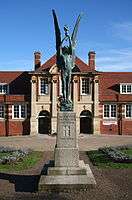 Great Malvern War Memorial. Photograph courtesy Andrew Kelsall.
Great Malvern War Memorial. Photograph courtesy Andrew Kelsall.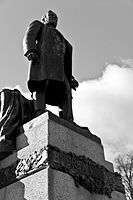 Statue of Andrew Carnegie. Photograph shown courtesy Ross Strachan.
Statue of Andrew Carnegie. Photograph shown courtesy Ross Strachan.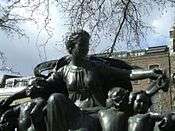 Part of Lincolns Inn Fields Memorial
Part of Lincolns Inn Fields Memorial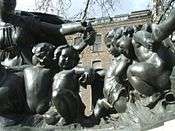 Part of Lincolns Inn Fields Memorial
Part of Lincolns Inn Fields Memorial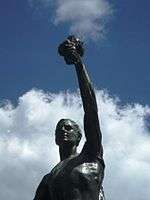 Figure on Kingston-upon-Thames War Memorial
Figure on Kingston-upon-Thames War Memorial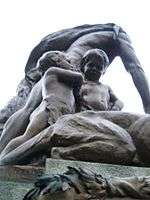 Crompton War Memorial
Crompton War Memorial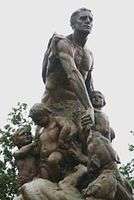 Crompton War Memorial
Crompton War Memorial Plaque on Reigate and Redhill War Memorial
Plaque on Reigate and Redhill War Memorial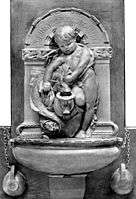 Fountain mural. From "Academy Architecture" 1904-1908.
Fountain mural. From "Academy Architecture" 1904-1908. Phryne front. From "Academy Architecture" 1904-1908.
Phryne front. From "Academy Architecture" 1904-1908. Phryne back. From "Academy Architecture" 1904-1908.
Phryne back. From "Academy Architecture" 1904-1908.- St Michael's in Cornhill. Shown courtesy Lonpicman.
 Great Malvern War Memorial. Shown courtesy Philip Halling.
Great Malvern War Memorial. Shown courtesy Philip Halling.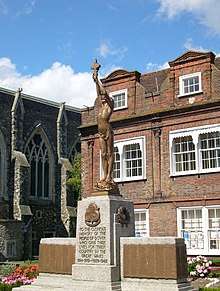 Dover War Memorial (1924) in public square in front of Dover Town Council building
Dover War Memorial (1924) in public square in front of Dover Town Council building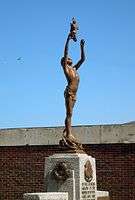 Dover War Memorial (1924), youth holding aloft a burning cross against a bright blue sky
Dover War Memorial (1924), youth holding aloft a burning cross against a bright blue sky
References
- Newhaven Tribute Newhaven Town Council. Retrieved 16 October 2012
- Gurkha Archives. Retrieved 16 October 2012
- Jacob's Fountain www.malvern-hills.co.uk/malvernspa/well-info/jacobs.html Retrieved 16 October 2012
- Richard Reginald Goulden: The Sculptor of Dover War Memorial. The Dover War Memorial Project. Retrieved 17 August 2012.
- "Victoria and Albert Museum Decorative Sculpture". V&A museum. Archived from the original on 17 July 2009. Retrieved 5 February 2009.
- V&A Public Monument and Sculpture Association. Retrieved 16 October 2012
- Statue of Andrew Carnegie British Listed Buildings. Retrieved 16 October 2012
- The Dolly Burton Memorial The Victorian Web. Retrieved 16 October 2012
- Eadweard Muybridge THE COMPLEAT EADWEARD MUYBRIDGE. Retrieved 16 October 2012
- Memorial to Margaret Ramsay MacDonald The website of Bob Speel. Retrieved 16 October 2012
- Margaret Ramsay MacDonald London Remembers. Retrieved 16 October 2012
- Middlesex County and Middlesex Regiment Memorial UKNIWM. Retrieved 16 October 2012
- Crompton UKNIWM. Retrieved 16 October 2012
- Brightlingsea UKNIWM. Retrieved 15 October 2012
- St Michael's Church UKNIWM. Retrieved 15 October 2012
- Hornsey School UKNIWM. Retrieved 15 October 2012
- Ist Division Memorial at Chapeau Rouge The Long, Long Trail The British Army in the Great War. Retrieved 15 October 2012
- Dover War Memorial UKIWM website. Retrieved 14 October 2012
- Dover War Memorial (2) The Dover War Memorial Project. Retrieved 15 October 2012
- Bank of England- St Christopher Statue UKNIWM. Retrieved 15 October 2012
- Kingston-upon-Thames War Memorial UKIWM website. Retrieved 14 October 2012
- Reigate and Redhill War Memorial UKIWM website. Retrieved 14 October 2012
- Great Malvern War Memorial UKIWM website. Retrieved 14 October 2012
- Great Malvern War Memorial Great Malvern library and war memorial. Retrieved 16 October 2012
- Gateshead War Memorial UKIWM website. Retrieved 14 October 2012
- Gateshead PMSA Public Sculpture and Monument Association. Retrieved 15 October 2012
External links
- "Biography". YourArchives. Retrieved 5 February 2009.